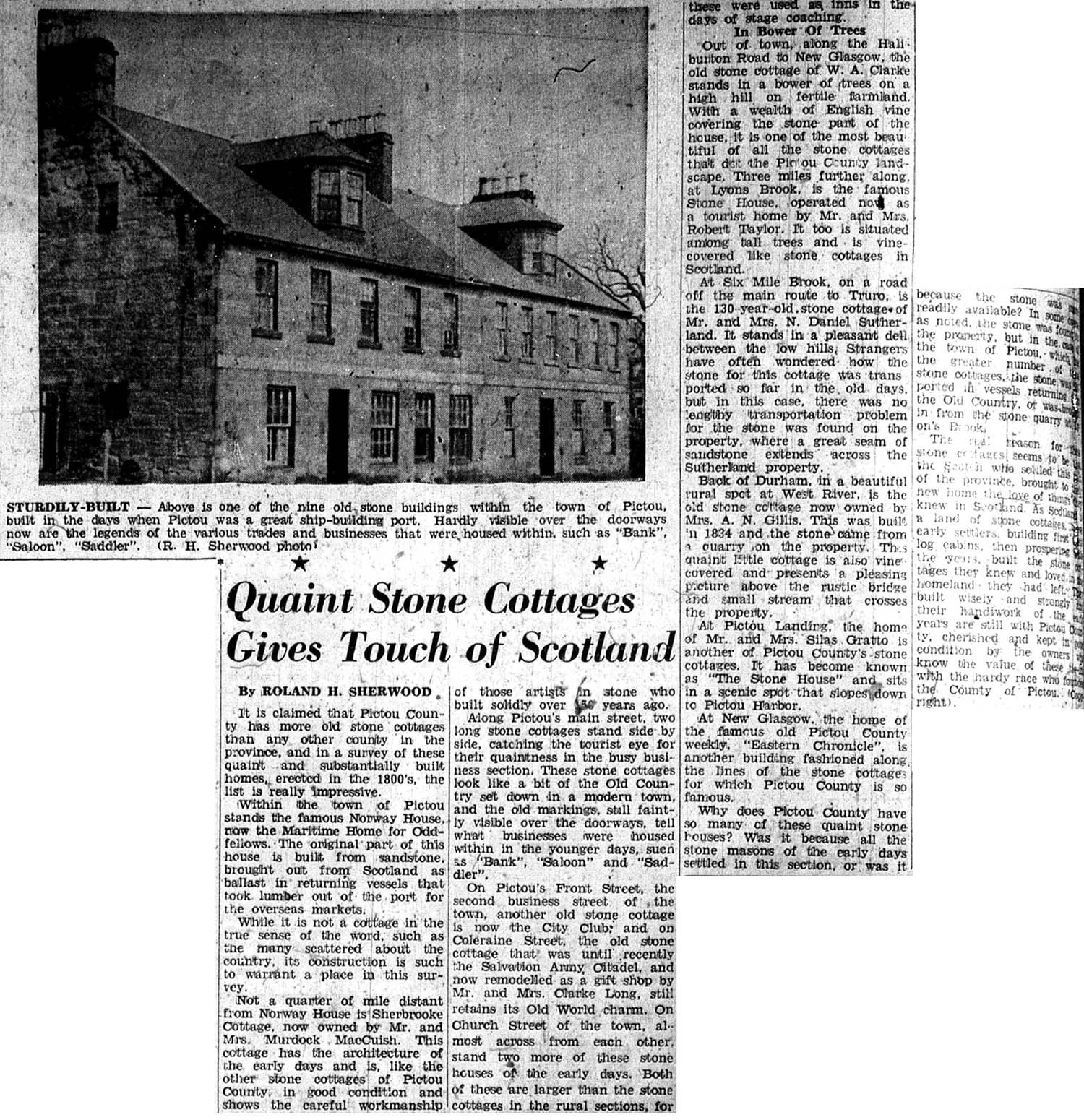
The Pictou Advocate, 3 Dec 1953 by Roland H Sherwood
Quaint Stone Cottages Gives Touch of Scotland
It is claimed that Pictou County has more old stone cottages than any other county in the province, and in a survey of these quaint and substantially built homes, erected in the 1800's the list is really impressive.
Within the town of Pictou stands the famous Norway House, now the Maritime Home for Oddfellows. The original part of this house is built from sandstone, brought out from Scotland as ballast in returning vessels that took lumber out of the port for the overseas markets.
While it is not a cottage in the true sense of the word, such as the many scattered about the country, its construction is such to warrant a place in this survey.
Not a quarter of mile distant from Norway House is Sherbrooke Cottage, now owned by Mr. and Mrs. Murdock MacCuish. This cottage has the architecture of the early days and is like the other stone cottages of Pictou County in good condition and shows the careful workmanship of those artists in stone who built solidly over 150 years ago.
Along Pictou's main street, two long stone cottages stand side by side, catching the tourist eye for their quaintness in the busy business section. These stone cottages look like a bit of the Old Country set down in a modern town, and the old markings, still faintly visible over the doorways, tell what businesses were housed within the younger days, such as "Bank", "Saloon", and "Saddler".
On Pictou's Front Street, the second business street of the town, another old stone cottage is now the City Club and on Coleraine Street, the old stone cottage that was until recently the Salvation Army, Citadel, and now remodelled as a gift shop by Mr. and Mrs. Clarke Long, still retains its Old World charm. On Church Street of the town, almost across from each other, stand two more of these stone houses of the early days. Both of these are larger than the stone cottages in the rural sections, for these were used as inns in the days of stage coaching.
In Bower Of Trees
Out of town, along the Haliburton Road to New Glasgow, the old stone cottage of W. A. Clarke stands in a bower of trees on a high hill on fertile farmland. With a wealth of English vine covering the stone part of the house, it is one of the most beautiful of all the stone cottages that dot the Pictou County landscape. Three miles further along at Lyons Brook, is the famous Stone House, operated now as a tourist home by Mr. and Mrs. Robert Taylor. It too is situated among tall trees and is vinecovered like stone cottages in Scotland.
At Six Mile Brook, on a road off the main route to Truro, is the 130 years old, stone cottage of Mr. and Mrs. N. Daniel Sutherland. It stands in a pleasant dell between the low hills. Strangers have often wondered how the stone for this cottage was transported so far in the old days, but in this case, there was no lengthy transportation problem for the stone was found on the property, where a great seam of sandstone extends across the Sutherland property.
Back of Durham, in a beautiful rural spot at West River, is the old stone cottage now owned by Mrs. A. N. Gilllis. This was bult in 1834 and the stone came froma quarry on the property. This quaint little cottage is also vinecovered and presents a pleasing picture above the rustic bridge and small stream that crosses the property.
At Pictou Landing, the home of Mr. and Mrs. Silas Gratto is another of Pictou County's stone cottages. It has become known as "The Stone House" and sits in a scenic spot that slopes down to Pictou Harbor.
At New Glasgow, the home of the famous old Pictou County weekly, "The Eastern Chronicle", is another building fashioned along the lines of the stone cottages for which Pictou County is so famous.
Why does Pictou County have so many of these quaint stone houses? Was it because all the stone masons of the early days settled in this section, or was it because the stone was more readily available? In some cases as noted, the stone was forged on the property, but in the case of the town of Pictou, which has the greater number of these stone cottages, the stone was imported in vessels returning from the Old Country, or was brought in from the stone quarry in Lyon's Brook.
The real reason for these stone cottages seems to be -- the Scotch who settled this part of the province, brought to their new home the love of things they knew in Scotland. As Scotland -- a land of stone cottages, -- early settlers, building first -- long cabins, then prospering -- the years, built the stone cottages they knew and loved in their homeland they had left. They built wisely and strongly as their handiwork of the early years are still with Pictou County, cherished and kept in good condition by the owners who know the value of these -- with the hardy race who formed the County of Pictou.
| File number: | PA03121953p10 |
| Contributor: |
|
| Tags: | Norway House, Maritime Home for Oddfellows, stone cottage, stone house, Sherbrooke Cottage, Thomas McCulloch, Edward Mortimer, Emma and Murdoch MacCuish, Front Street, Coleraine Street, Pictou town, Historic Pictou, Salvation Army, Clarke Long, Church Street, Haliburton Road, W A Clarke, Six Mile Brook, N Daniel Sutherland, Durham, West River, A N Gillis, Pictou Landing, Silas Gratto, The Stone House, Eastern Chronicle, New Glasgow, Lyons Brook, quarry, Scotland, sandstone |
| Views: | 1428 |
| Uploaded on: | March 2, 2019 |
| Source: | Pictou Advocate/Roland H Sherwood |